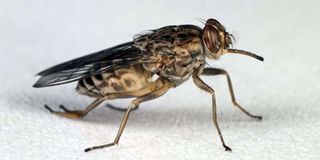Kenya in ambitious Sh7.7 billion drive to eliminate tsetse fly

What you need to know:
- The ambitious strategic project seeks to eliminate the pest that infests about 138,000 square kilometres of fertile land in 38 counties in Kenya.
- The programme aims to eradicate the tsetse fly insect population to boost human health, livestock production and tourism.
- Kenttec chief executive Dr Pamela Olet said the programme, dubbed the Progressive Control Pathway, aims at saving the country Sh21.3 billion in losses every year.
Kenya has launched a programme to eliminate the tsetse fly that causes sleeping sickness in humans and trypanosomiasis in cattle.
The ambitious strategic project seeks to eliminate the pest that infests about 138,000 square kilometres of fertile land in 38 counties in Kenya.
The biting insect has long been the scourge of the savannah grasslands of the country, acting as a carrier for trypanosomes, the parasites that cause trypanosomiasis.
Trypanosomiasis affects both humans and livestock and is known as sleeping sickness or Human African Trypanosomiasis (HAT) in humans.
When it affects livestock, it is referred to as nagana or African Animal Trypanosomiasis (AAT).
According to Dr Robert Monda, who chairs the Kenya Tsetse and Trypanosomiasis Eradication Council (Kenttec), the programme aims to eradicate the tsetse fly population to boost human health, livestock production and tourism.
“Areas infested with tsetse flies are most suitable for livestock and crop production, meaning the fly poses a threat to the achievement of food security and nutrition,” Dr Monda said.
“Eradicating tsetse flies and trypanosomiasis from the large tracts of land that are currently affected is critical in creating livestock export zones (LEZs). This will boost the value of livestock in those areas and promote tourism by opening up national parks to more visitors, who were restricted by the risk of contracting sleeping sickness,” he added.
HUGE COST
Speaking to the Nation in Nairobi on Friday, Dr Monda said its implementation will cost about Sh7.7 billion.
Kenttec chief executive Dr Pamela Olet said the programme, dubbed the Progressive Control Pathway, aims at saving the country Sh21.3 billion in losses every year.
“In general, Kenya loses about sh 21.3 billion or $200 million due to human and animal trypanosomiasis every year. The Rhodesian sleeping sickness is endemic in the Lake Victoria basin and lower Mara regions where about 11 million people are at risk,” said Dr Olet.
According to Daniel Gamba, who heads Kenttec’s Technical Service, the tsetse fly, or glossina spp, transmits eight subspecies of the protozoan trypanosoma in the country.
“In eastern and southern Africa, the tsetse fly transmits the trypanosoma brucei rhodesiense subspecies, which is responsible for the chronic form of sleeping sickness. The fly also transmits the trypanosoma vivax, congolense and vivax subspecies that cause nagana or animal trypanosomiasis in the region,” said Mr Gamba.
He said Kenttec had used several technologies to control the insect in endemic areas. They include the push and pull method that uses a combination of repellents to push the flies away from some areas, and attractants to pull them into areas where they are either trapped for research or killed.
“We use a number of technologies to control the insect, including traps that include chemicals that attract the insects to nets that trap and also kill the insects depending on their design and purpose,” said Mr Gamba.
RESEARCH
To achieve its goals, Kenttec is also working with a number of research bodies including the International Centre of Insect Physiology and Ecology (Icipe), Kenya Agricultural Research Organization (Kalro), International Livestock Research Institute (Ilri) and the Kenya Wildlife Service (KWS).
Icipe researchers have developed a wearable animal collar that emits the smell of the waterbuck, an animal that the tsetse fly does not bite.
According to Icipe entomologist Dr Michael Okal, the technology was developed after studies of various wild animal species revealed that the fly does not bite the waterbuck.
"From our studies on the tsetse fly’s feeding habits, we found that it does not bite the waterbuck, the zebra, elephants and lions, among other animal species," he said.
“We analysed the waterbuck’s smell and the chemicals involved in its production. We then designed the cows’ collar to emit a similar smell to repel tsetse flies.”
The study has so far involved 500 farmers in the Shimba Hills area and their 4,000 animals.
According to Josephine Wayua, a farmer in Tangini Village, Kubwa South Ward, Kwale County, the technology has helped her cut losses in her herd, and increase the number from just three to 12.
"Before participating in the Icipe project, I was only able to dig up to half an acre per day by hand. Now I can plough up to three acres a day,” the widow and mother of three told the Nation.




